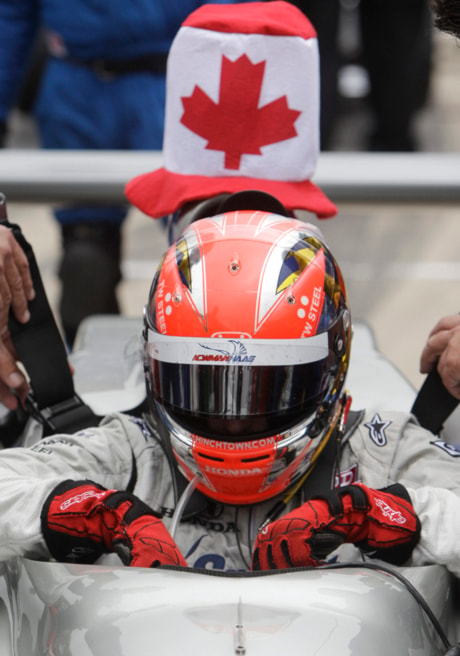EDMONTON — Rookie IndyCar driver James Hinchcliffe figures getting rammed by the chrome horns of Paul Tracy in Toronto last week was the best thing that could have happened to him.
“I think it did a lot, especially with the Canadian fans. Obviously 99 per cent of them know who Paul Tracy is, and maybe 10 per cent knew who James Hinchcliffe was up to that point,” the 24-year-old from Oakville, Ont., said in an interview as he prepared for Sunday’s Edmonton Indy.
“Now all of a sudden there’s another Canadian on the block.”
Hinchcliffe and Tracy ran wheel to wheel before coming together fighting for position through a corner at Toronto.
Tracy went for a spin and had to get a new wing while Hinchcliffe punctured a tire. Both finished the race well back of winner Dario Franchitti. Afterward, each blamed the other.
Hinchcliffe said it was a defining moment in his rookie season.
“If any driver is going to expose a weakness in another driver’s defence, it’s going to be Paul, so I think it was important to show that we weren’t going to give up the corner.
“I think it served me pretty well.”
He said there will be no bad blood when the two come together again on the new track at Edmonton’s City Centre Airport this weekend.
“We spoke about it after the race. There are no (hard) feelings.”
It was one more on-track lesson in what Hinchcliffe says has been a steep learning curve in 2011.
Even though his fulltime ride with Sprott — a Toronto-based asset management firm — didn’t come together until after the season started, he sits 15th in the IndyCar standings with 158 points and is still within striking distance of J.R. Hildebrand for top rookie honours.
He’s found the top-10 in four races, with a fourth-place finish in Long Beach, Calif., in April.
After spending the previous two seasons in the Indy Lights development series, he says the transition has been challenging physically and mentally.
“When you’re coming out of Indy Lights it’s a sprint race, it’s 50 minutes, maybe an hour. There’s no pit stops, there’s no strategy,” he said.
Now he’s adjusting to a new rhythm.
When he arrives on a race weekend, a 70-page report on the track is waiting for him: previous results, racing lines, driver comparison, setup information on wings, springs, dampers, gear ratios, and ride heights.
When the race is over there will be another 50-page document literally documenting his mistakes by the numbers.
On track, he’s learning to adapt to multiple setups, such as when he takes on fuel or adds a fresh set of tires, adjusting the car as the race is going on.
He’s learning the feel of the car, radioing back what’s working and what’s not for the engineers. Get it right and the engineers can find the extra one-tenth of a second that can win a race. Get it wrong and crews are in a deep hole, like last month in Milwaukee, when Hinchcliffe said he gave setup feedback that actually made the car worse.
On track, the education is coming at him in a blur.
The faster speeds on road courses required a step up in reaction time, he said, but the ovals have been off the hook. Cars moving at blinding speed, filling his mirrors and jamming his gearbox. Whereas before he had three-tenths of a second to react, now he’s got one-tenth. Ovals that seemed endless in a slower Indy Lights machine now feel like he’s racing in the drum of a washing machine.
“It was a big surprise, and a big education,” he said.
Veteran racer Oriol Servia, his teammate at Newman/Haas, has been a solid supporter and valued mentor, pointing out stuff not found on any telemetry readout.
Like during practice at the Indy 500 in May.
Hinchcliffe’s car felt loose at the back. Or maybe it didn’t. Hinchcliffe couldn’t tell.
He pulled into the pits. “I think the car has a little bit of a nervous rear,” he remembers telling the engineers and crew. “I’m not sure, so let’s keep working on the front end.”
Servia took him aside and shut that down, telling the rookie that any wiggle in the back — any wiggle — can quickly become a backwards spin and a bone-crushing pile drive into the safety barrier.
“Any feeling about the rear whatsoever you come in right away,” he remembered Servia telling him. “Don’t let anybody tell you different. You fix that.”
Said Hinchcliffe: “It helped me get a little bit of direction when I was trying to figure things out.”
Now he just has to avoid the chrome horns.
